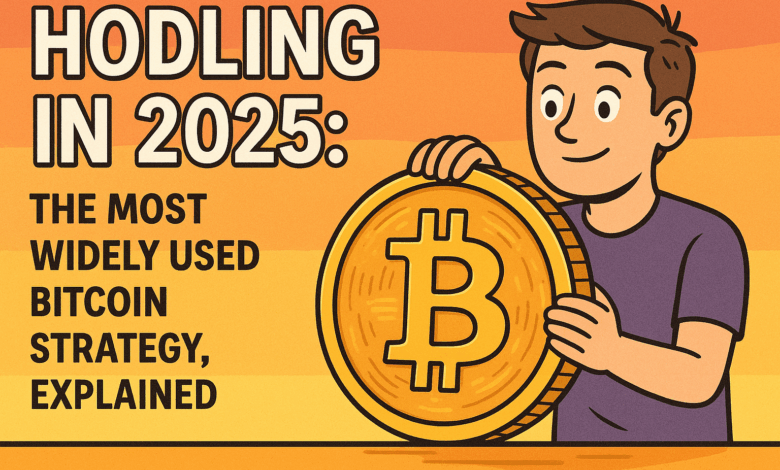The Most Widely Used Bitcoin Strategy, Explained

Introduction: HODLing—Smart or Stagnant?
The term “HODLing”—a misspelling that turned into a crypto mantra—originated from a 2013 BitcoinTalk post where an emotional investor vowed to “HODL” his BTC through a market downturn. What started as a typo gradually turned into a philosophy: a commitment to ride out volatility and resist panic selling. But here we are in 2025, facing a dramatically different crypto landscape. Institutional players have entered en masse, regulatory clarity is evolving, and innovations across DeFi and AI tokens have redefined the playing field. So, the crucial question becomes: Does HODLing still make sense in a mature market, or has it devolved into a passive, outdated strategy amid more dynamic investment opportunities?
The Origins of HODLing
The “HODL” mindset took root during one of Bitcoin’s infamous crashes, reflecting a resilient sentiment among early adopters. It became a badge of honor for those who refused to capitulate in the face of extreme volatility. When Bitcoin surged to near $20,000 in 2017, HODLers were vindicated. The crash of 2018 tested that ideology, yet again, many HODLers remained steadfast, later reaping the rewards when Bitcoin hit new all-time highs in 2020 and 2021.
By 2021, HODLing had become a cornerstone of crypto culture. Success stories of early investors turning modest BTC holdings into generational wealth became the stuff of legend—bolstering the belief that time in the market beats timing the market. Forums, Twitter threads, and even mainstream financial media began to adopt the term, cementing its place in the broader investing lexicon.
But markets evolve. And as cryptocurrencies integrate more deeply into the global financial ecosystem, clinging to a singular, passive strategy may no longer be the most effective method of capital growth. Especially as the market matures, the nuances of strategic investing require more than just holding onto your assets.
The Problem with HODLing in 2025
Fast forward to 2025, and Bitcoin is no longer an outlier or curiosity. It’s a validated asset class. Central banks and sovereign wealth funds now hold BTC in their reserves. Major corporations integrate it into their balance sheets. ETFs offering Bitcoin exposure trade on major exchanges worldwide. While this brings legitimacy and liquidity, it also brings something else: reduced volatility and diminishing returns.
Gone are the days of explosive, triple-digit annual gains. Now, with institutional participation comes price stabilization. That’s great for wealth preservation—but less so for high-growth aspirations. Volatility, once the enemy, was also opportunity. In a stable market, those opportunities for rapid growth decline sharply.
Moreover, as more investors simply hold their assets, trading volume can stagnate. Crypto always thrived on active markets, where the constant buying and selling cycled liquidity and created volatility. In 2025, the emphasis on “safe holding” is starting to drain some of that dynamism from the sector—particularly when it comes to Bitcoin.
The irony is clear: widespread HODLing is transforming crypto from a high-beta playground into a relatively predictable asset class. This shift brings substantial benefits from a security and credibility standpoint—but it also calls into question the long-term growth potential of passively held assets, especially in an environment teeming with fresh, profit-generating innovations.
What Smart Investors Are Doing in 2025
Clever investors in 2025 are not discarding Bitcoin—they’re upgrading their strategies. It’s not about choosing between holding or selling; it’s about unlocking utility and deploying capital dynamically.
- Staking and Yield Generation: While you can’t stake Bitcoin in its native form, synthetic or wrapped BTC can be staked on numerous DeFi platforms to earn passive income. BTC-backed assets like wBTC and tBTC offer access to higher-yield opportunities without exposing you to completely new tokens.
- Options and Derivatives Trading: Sideways or slightly bearish markets are ripe for options strategies such as covered calls or cash-secured puts. Platforms like Deribit and native decentralized options markets allow investors to profit even when the price doesn’t move significantly.
- Rotating into High-Growth Assets: Projects focused on scalability (i.e., Layer-2s like Arbitrum and zkSync), artificial intelligence integrations, and interchain interoperability are producing significant ROI. Smart capital is rotating into these early-stage ecosystems, looking for the next catalyst wave.
- Utilizing Bitcoin DeFi Protocols: Innovations in Bitcoin-native DeFi—like Stacks, Sovryn, and Babylon—now allow users to earn yield, lend BTC, or gain leveraged exposure directly within Bitcoin’s ecosystem, using smart contracts designed for security and transparency.
All these strategies share a common thread: proactive allocation. Keeping BTC in cold storage is prudent for long-term security, but complementing it with protocols that offer utility can dramatically enhance your overall portfolio performance.
Bitcoin as a Store of Value—Not a Growth Engine
The consensus is clear: Bitcoin is digital gold. Its growing adoption as a long-term store of value solidifies that narrative. Much like real estate or physical gold, it offers a hedge against fiat devaluation and geopolitical instability. But it’s increasingly evident that Bitcoin has shifted from being a growth engine to becoming an anchor asset.
That doesn’t mean investors should abandon it—it just means it’s time to rethink its purpose within your portfolio. Rather than seeking alpha from Bitcoin’s price movements alone, use that BTC as productive collateral. Platforms now allow you to borrow stablecoins or other digital assets against your BTC without selling it, preserving upside exposure while gaining liquidity.
Alternatively, institutions are now tokenizing real-world assets—like real estate, treasuries, and commodities—and allowing BTC to be used as the bridge asset. These innovations offer the chance to generate real-world yields through tokenized finance, expanding BTC’s utility beyond speculation.
Opportunities Beyond the HODL
In 2025, the crypto ecosystem is broader than ever. Bitcoin NFTs (Ordinals), smart contract rollups, tokenized real estate, cross-chain communication protocols, and zero-knowledge proof computing systems are reshaping what blockchain technology is capable of.
Bitcoin-native DeFi protocols are evolving quickly. Unlike Ethereum’s DeFi summer in 2020, these protocols are tailored to Bitcoin’s ethos of decentralization and sound money, but now include modern features such as synthetic assets, decentralized lending, and interest-bearing instruments.
Meanwhile, newer blockchains using AI-enhanced consensus mechanisms offer unique avenues for alpha. These platforms harness predictive intelligence to optimize staking rewards, transaction throughput, and network security. Investors who only HODL risk missing the upside from these bleeding-edge sectors.
Additionally, multichain bridges make asset flow seamless across different networks. Smart investors are now participating in entire blockchain economies—not just single tokens. By tapping into interoperable ecosystems, they’re able to chase yield wherever it is most lucrative, without convoluted onboarding processes or walled gardens of the past.
Conclusion: HODLing Is Dead—Long Live Dynamic Holding
HODLing still has its place in the modern investor’s toolkit—but as a portion of a much broader and more adaptable strategy. For wealth preservation and low-time preference investing, HODLing Bitcoin remains valid. But if you’re a growth-driven investor, the landscape has shifted.
The HODL strategy made sense when markets were new, options were limited, and volatility was rampant. But in 2025’s mature and interconnected financial environment, merely sitting on an asset doesn’t cut it. The modern investor needs to be agile, diversified, and data-driven.
It’s time to embrace what we’ll call “Dynamic Holding.” This approach honors the long-term vision of Bitcoin while leveraging decentralized finance, emerging tokens, and yield-generating products to grow capital in real time.
In an era where opportunity cost is higher than ever, the most successful investors will be those who see Bitcoin not merely as the end game—but as a gateway to accelerating their entire crypto investment thesis.
Source link




